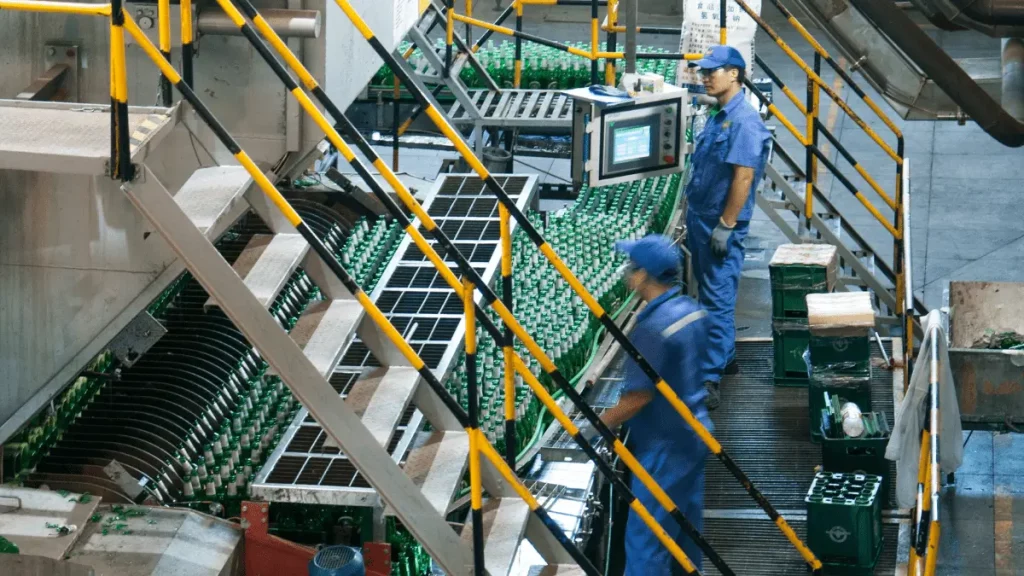There are 3 key benefits of using the right lean manufacturing tools. This includes effectively:
- — Reducing waste
- — Increasing efficiency
- — Delivering more value to your customers
The goal of lean manufacturing is to improve efficiency and productivity on the shop-floor. This is done by getting the most out of each resource with the help of lean manufacturing tools. Some lean manufacturing tools might be more fitting for one organization versus another. But, some of the most useful, basic lean manufacturing tools you can use to help jumpstart your lean journey include:
- 1. Kaizen
- 2. 5S
- 3. Kanban
- 4. PDCA
- 5. Value Stream Mapping
Kaizen
Kaizen is one of the most important lean manufacturing tools you can use to foster continuous improvement in all aspects of your organization. For example, in quality, technology, processes, productivity, safety, and organizational culture.
Essentially, Kaizen is a Japanese business philosophy that involves continuously improving an organization’s processes and involves all employees, from upper management to the cleaning crew. As a result, suggestions for improvement are collected from every part of the business. For instance, management, production, logistics, finance, and etc. Usually, individual improvements don’t result in major changes by themselves. Instead, continuous efforts of small changes results in major improvements in productivity and efficiency on the shop floor, while simultaneously reducing waste.
In short, organizations that practice Kaizen create a culture in which employees feel empowered to make suggestions for improvements anywhere in the business.
5S
5S is a systematic approach to workplace organization and helps keep workplaces clean, safe, and organized to reduce waste and optimize productivity. This approach involves five fundamental guidelines to make your workplaces more efficient and effective:
- 1. Sort — separate and eliminate what is not needed in the workspace
- 2. Set in Order — organize the remaining items
- 3. Shine — clean and inspect the work area
- 4. Standardize — standardize best practices for the workspace
- 5. Sustain — continuously apply those standards to ensure continuous improvement
5S is one of the most used lean manufacturing tools in various industries such as manufacturing, software, and healthcare. Moreover, it can be one of the easiest lean manufacturing tools to start your lean efforts. Use 5S with Kaizen and Kanban to create the most efficient shop-floor possible.
Kanban

In Japanese, the word “kanban” means “visual board” or a “sign”. In lean manufacturing, Kanban is a popular workflow management method that helps you visualize work, maximize efficiency, and continuously improve. Tasks and assignments are represented on Kanban boards. As a result, this allows you to optimize work processes across multiple teams. Essentially, this lean manufacturing tool ensures that employees have what they need, where they need it, and when they need it.
By using Kanban, employers can better manage inventory and reduce the overflow of stock, allowing them to focus on stockpiled items instead. In turn, manufacturers and factory workers can respond to actual needs rather than making guesses to prepare for the future. This will help to reduce waste and improve efficiency on the shop-floor.
Kanban is closely related to Kaizen — you should encourage individuals and teams to participate in continuously improving Kanban solutions and overall manufacturing processes. You can also implement Kanban with 5S in addition to Kaizen.
PDCA
The PDCA cycle is one of the most basic lean manufacturing tools you can use to manage and operationalize continuous improvement. It stands for Plan-Do-Check-Act, or sometimes Plan-Do-Check-Adjust, and provides a comprehensive framework for identifying and solving problems quickly. Essentially, it enables teams to avoid recurring mistakes and instead, improve processes.The PDCA cycle includes four steps:
- 1. Plan what needs to be done
- 2. Do the work required for that plan
- 3. Check the results of the work
- 4. Act/Adjust to fix any dissatisfying results
Value Stream Mapping
Value Stream Mapping, or VSM, is another one of the most important lean manufacturing tools you can use to ensure your customers that you will provide the value they are looking for.
VSM is a visual lean manufacturing tool that helps manufacturers and factory workers optimize their production processes. In essence, it allows you to create a detailed visualization of all the steps in your processes. By using a value stream map, you can see the flow of goods from the supplier to the customer throughout your organization.
The primary purpose of creating a value stream map is so that you can see where you can improve your process by visualizing both its value-adding and wasteful steps. It is required of you to identify every crucial step of your workflow and evaluate how it brings value to your customers. Doing this allows you to perform an in-depth analysis of your processes and provides you with accurate, actionable insights into where you should make changes to improve the way you do things.





